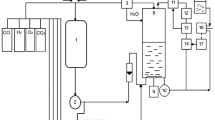Abstract
Polyhydroxybutyrate (PHB) was produced by Ralstonia eutropha DSM 11348 (formerly Alicaligenes eutrophus) in media containing 20–30 g l−1 casein peptone or casamino acids as sole sources of nitrogen. In fermentations using media based on casein peptone, permanent growth up to a cell dry mass of 65 g l−1 was observed. PHB accumulated in cells up to 60%–80% of dry weight. The lowest yields were found in media without any trace elements or with casamino acids added only. The residual cell dry masses were limited to 10–15 g l−1 and did not contain PHB. The highest productivity amounted to 1.2 g PHB l−1 h−1. The mean molecular mass of the biopolymer was determined as 750 kDa. The proportion of polyhydroxyvalerate was less than 0.2% in PHB. The bioprocess was scaled up to a 300-l plant. During a fermentation time of 39 h the cells accumulated PHB to 78% w/w. The productivity was 0.98 g PHB l−1 h1.
Similar content being viewed by others

Author information
Authors and Affiliations
Additional information
Received: 8 July 1998 / Accepted: 26 August 1998
Rights and permissions
About this article
Cite this article
Bormann, E., Leißner, M., Roth, M. et al. Production of polyhydroxybutyrate by Ralstonia eutropha from protein hydrolysates. Appl Microbiol Biotechnol 50, 604–607 (1998). https://doi.org/10.1007/s002530051342
Issue Date:
DOI: https://doi.org/10.1007/s002530051342



